2011
“Pathophysiological and pharmacological study of left ventricular dysfunction in a mouse model of Marfan syndrome”
$50,000 Funded by TFF
Julie De Backer, MD, PhD
University of Ghent, Belgium
The clinical cardiovascular features of Marfan syndrome (MFS) mainly include progressive enlargement of the aortic root, often leading to aneurysm formation and eventually to (often fatal) aortic dissection (ie tear in the aortic wall). In addition to this major cardiovascular manifestation, several studies have confirmed the existence of (mildly) reduced function of the heart muscle (reduced capacity of the heart muscle to contract) in MFS patients. The underlying explanation for this finding is largely unknown although it is likely that signaling of a very specific molecule (the transforming growth factor ß), which is impaired in many of the manifestations seen in MFS, plays a role. One possibility to study the cause of this reduced heart function in MFS is to study a mouse model, allowing detailed in vivo (life) and in vitro (laboratory) studies. This information may be very valuable, not only for the study of MFS but also for increasing our understanding of the mechanisms of heart muscle dysfunction in general.
We want to investigate the underlying mechanism of heart muscle dysfunction in a previously validated MFS mouse model (Fbn1C1039G/+) using a dedicated cardiac ultrasound system on the one and specific stainings, protein and gene analysis of cardiovascular tissue on the other hand. The TGFß protein has been shown to play a central role in the pathogenesis of MFS. TGFß activates different intracellular signaling pathways The contribution of these pathways on the development of heart muscle dysfunction in the Fbn1C1039G/+ mouse model will be evaluated with immunohistological stainings (microscopic detection of proteins in a tissue section by using antibodies directed against specific proteins) and Western Blot (technique using antibody mediated detection of specific proteins in cell free extracts after protein separation (according to size) by electrophoresis) performed on heart tissue. In addition we want to perform a pharmacological study in the Fbn1C1039G/+ mice in order to identify treatment options reducing the development of heart muscle dysfunction. Mice will be randomly assigned to receive either Losartan (a well known blood pressure lowering drug, also used for treatment of heart muscle dysfunction), or a specific agent blocking one of the pathways (ERK pathway inhibitor) or placebo. Treatments targeting this ERK pathway are very promising since they have been shown to reduce the progression of proximal aortic dilatation in a MFS mouse model and to ameliorate the heart muscle function in a mouse model of cardiomyopathy (disease of the heart muscle leading to a deterioration of the function of he heart muscle). Whether Losartan (an angiotensin I receptor blocker), primarily used to prevent aortic remodeling, may also have a beneficial effect on the heart muscle function, has not been investigated yet. Treatment effects will be evaluated by serial echocardiography and histological
Further funding acquired based on this research:
Research Grant from the Special Funds for Scientific Research of the Ghent University (200.000€) – promoter Julie De Backer. Start project Oct 2013 (4y)
